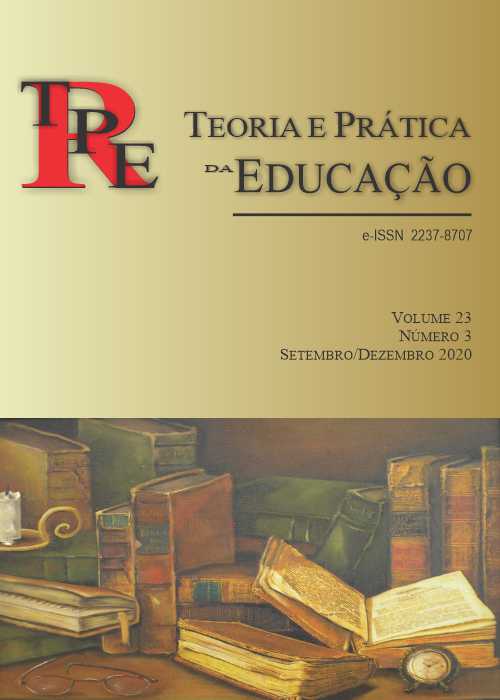PARENTS' PERCEPTION OF LEARNING TO READ IN PRESCHOOL THROUGH THE PHONIC METHOD
Abstract
This study investigates how children who started literacy in preschool experience reading outside it, considering the emotions raised in these children and in their caregivers. The research was carried out with preschool children, literate in reading through a variation of the phonic method. The parents' perspective, verified by their responses to a questionnaire, is the main data source. The analysis displays that the emotions shown by children learning to read are joy, satisfaction, interest, and desire to continue learning to read, and that their parents show surprise, admiration, joy, and satisfaction, seeing their young children reading, engaging in socio-communicative practices. The method used emerges as appropriate for pre-school literacy, since it is efficient and arouses positive emotions. Also, early literacy encourages children to actively enter the literate world, and parents to participate to their learning.
Downloads
References
BAKHTIN, M. Estética da criação verbal. São Paulo: Martins Fontes, 2006.
BRASIL. Ministério da Educação. Decreto n.º 9.765, de 11 de abril de 2019. Institui a Política Nacional de Alfabetização. Disponível em:
BARTOSZECK, A. B.; BARTOSZECK, F. K. Neurociência dos Seis Primeiros Anos - implicações educacionais. 2016. Disponível em:
BUCHWEITZ, A. Language and reading development in the brain today: neuromarkers and the case for prediction. J Pediatr, Rio de Janeiro, v. 92, n. 3, supl. 1, p.8-13, 2016. DOI:
BUCHWEITZ, A.; MASON, R.A.; TOMITCH, L.M.; JUST, M.A. Brain activation for reading and listening comprehension: an fMRI study of modality effects and individual differences in language comprehension. Psychol Neurosci, v.2, p.111-23, 2009.
CÂMARA JR., J. M. Estrutura da língua portuguesa. 16.ed. Petrópolis: Vozes, 1986.
CARPENTIERI, J.; FAIRFAX‐CHOLMELEY, K.; LITSTER, J.; VORHAUS, J. Family literacy in Europe: using parental support initiatives to enhance early literacy development. London: NRDC, Institute of Education, 2011. Disponível em:
CARVALHO, C. G.; CAMPOS JR., D. J.; SOUZA, G. A. D. B. Neurociência: uma abordagem sobre as emoções e o processo de aprendizagem. Rev. Univ. Vale do Rio Verde, v.17, n.1, p.1-10, jan.-jul. 2019.
COWEN, A. S.; KELTNER, D. Self-report captures 27 distinct categories of emotion bridged by continuous gradients. Proceedings of the National Academy of Sciences of the Unites States of America (PNAS). New York University, New York, NY, September, 2017, p.1-10. Disponível em:
DAMÁSIO, A. O livro da consciência: a construção do cérebro consciente. Lisboa: Temas & Debates, 2010.
DEHAENE, S. Os neurônios da leitura. Trad. L. Scliar-Cabral. Porto Alegre: Penso, 2012.
FERREIRO, E.; TEBEROSKY, A. Psicogênese da língua escrita. Porto Alegre: Artmed, 1999.
FRADE, I. C. A. S. Método alfabético e de soletração. Glossário Ceale: termos de alfabetização, leitura e escrita para educadores. Belo. Horizonte: UFMG, 2014. Disponível em:
GOSWAMI, U. Principles of learning, implications for teaching: A cognitive neuroscience perspective. Journal of Philosophy of Education, v. 42, n. 3‐4, p. 381-399, 2008.
GUERRA, L. B. O diálogo entre a Neurociência e a Educação: da euforia aos desafios e possibilidades. Revista Interlocução, v.4, p.3-12, 2011. Disponível em:
INDICADOR DE ALFABETISMO FUNCIONAL – INAF. Brasil 2018: Resultados preliminares. Instituto Paulo Montenegro. OnG Ação Educativa. Disponível em:
IZARD, C. E.; LIBERO, D. Z.; PUTNAM, P.; HAYNES, O. M. Stability of emotion experiences and their relations to traits of personality. Journal of Personality and Social Psychology, v.64, n.5, p.847-860, 1993.
KUHL, P. K. Early Language Learning and Literacy: Neuroscience Implications for Education. Mind, Brain, and Education, v.5, n.3, p.128-142, set. 2011. Disponível em:
NATIONAL INSTITUTE FOR LITERACY – NIL. Developing Early Literacy. Report of the National Early Literacy Panel. 2009. Disponível em:
NUNES, I.; PEREIRA, M. P.; SANTOS, M. S. V.; ROCHA, J. M. F. A importância do incentivo à leitura na visão dos professores da escola Walt Disney. Rev. Eletrônica Multidisciplinar da Faculdade de Alta Floresta, v.1, n.2, 2012. Disponível em:
PEREIRA, W. R.; RIBEIRO, M. R. R.; DEPES, V. B. S.; SANTOS, N. C. Emotional competencies in the process of teaching and learning in nursing, from the perspective of the neurosciences. Rev. Latino-Am. Enfermagem, Ribeirão Preto, v.21, n.3, p.663-669, June 2013. Disponível em:
REYNOLDS, M.; BESNER, D. Reading aloud is not automatic: Processing capacity is required to generate a phonological code from print. Journal of Experimental Psychology: Human Perception and Performance, v.32, p.1303-1323, 2006.
SCLIAR-CABRAL, L. Aventuras de Vivi. Florianópolis: Lili, 2013.
SCLIAR-CABRAL, L. Sistema Scliar de alfabetização: Fundamentos. Florianópolis: Lili, 2012.
SCLIAR-CABRAL, L. Guia prático de alfabetização. Florianópolis: Contexto, 2003.
SÉNÉCHAL, M. The effect of family literacy interventions on children’s acquisition of reading: from kindergarten to grade 3. Encyclopedia of Language and Literacy Development. London: Canadian Language and Literacy Research Network, 2008.
SIGNORINI, I.; DIAS, R. Até agora, só ferrada, cara! O cognitivo, o afetivo e o motivacional na alfabetização de jovens. In: BAGNO, M. (Org.). A linguística da norma. São Paulo: Loyola, 2002.
SHAYWITZ, S. E.; SHAYWITZ, B. A. Paying attention to reading: the neurobiology of reading and dyslexia. Dev Psychopathol.v.20, p.1329-49, 2008.
SHAYWITZ, S. Overcoming dyslexia: A new and complete science-based program for reading problems at any level. New York: Alfred A. Knopf, 2003.
TASSONI, E. C. M. Afetividade na aprendizagem da leitura e da escrita: uma análise a partir da realidade escolar. Rev. Estudos e Pesquisas em Psicologia, Rio de Janeiro. v.13, n.2, 2013. Disponível em:
VIGOTSKI, L. S. A formação social da mente. São Paulo: Martins Fontes, 1991.
YONCHEVA, Y. N.; WISE, J.; MCCANDLISS, B. Hemispheric specialization for visual words is shaped by attention to sublexical units during initial learning. Brain and Language, v.145-146, p.23-33, June-July 2015. Disponível em:
Copyright (c) 2020 Teoria e Prática da Educação

This work is licensed under a Creative Commons Attribution-NonCommercial 4.0 International License.
Autores que publicam nesta revista concordam com os seguintes termos:
a) Os autores mantêm os direitos autorais e concedem à Revista Teoria e Pratica da Educação o direito de primeira publicação
b) Esta revista proporciona acesso público a todo o seu conteúdo, uma vez que isso permite uma maior visibilidade e alcance dos artigos e resenhas publicados.











